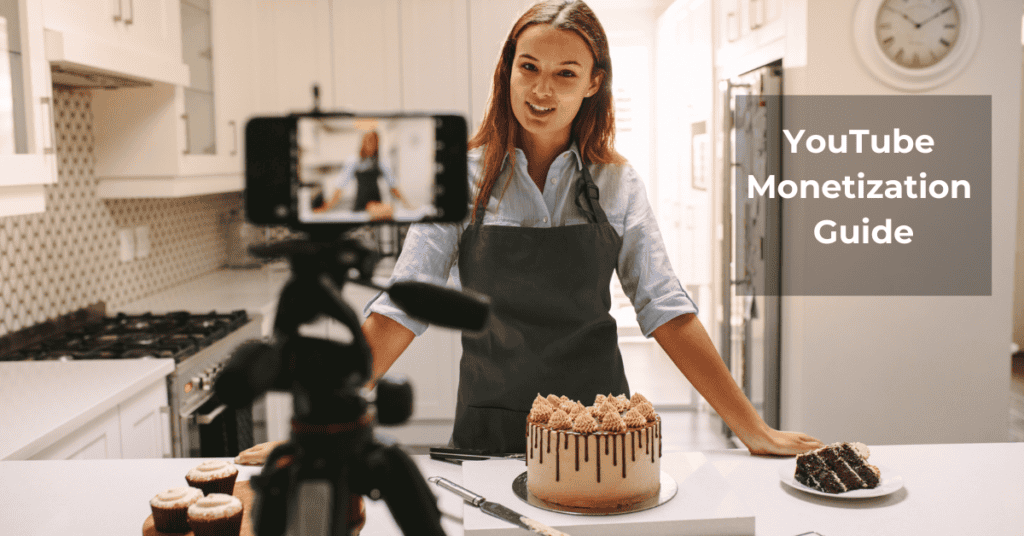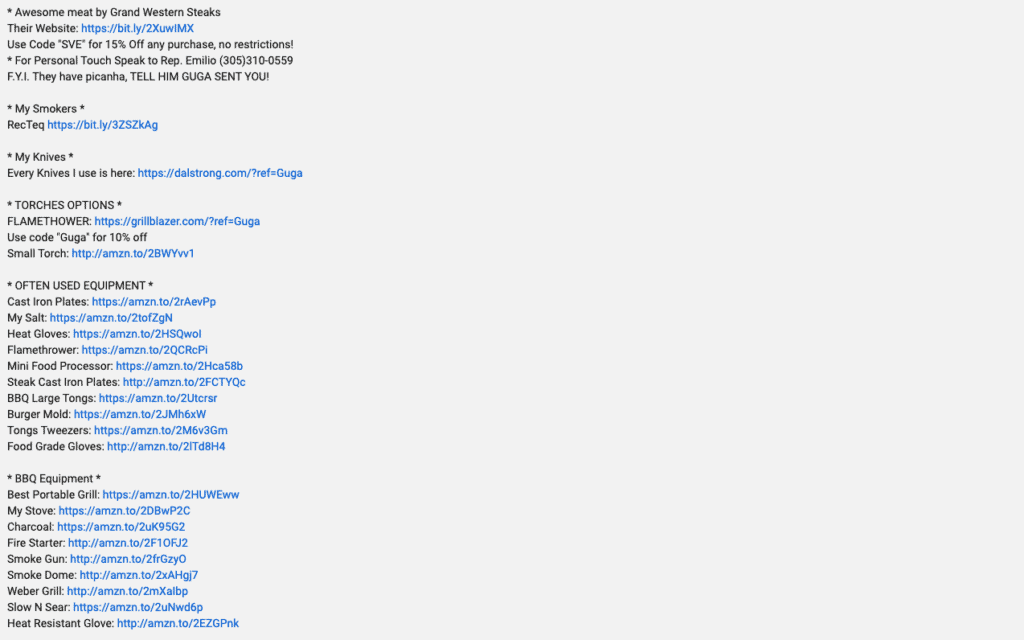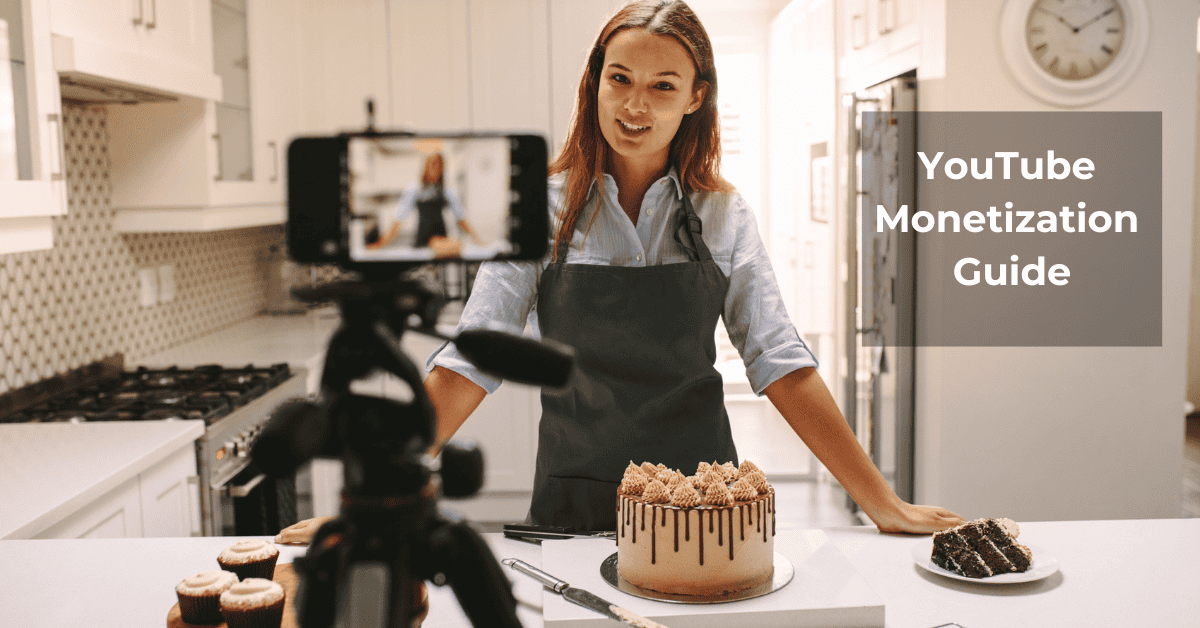
YouTube is an awesome revenue generator for content creators. With nearly 1 billion users worldwide, the platform presents you with a wide audience to share your videos with.
However, it takes time and dedication to get your channel to this monetization point. And it’s more than getting paid-off ads. You must consistently produce content that viewers love.
Follow our strategies for YouTube monetization and watch your channel become a thriving hub of creativity and income generation.
What Is YouTube Monetization?
YouTube monetization involves setting up your channel to earn income from your videos.
Traditionally, YouTubers have used ads as their primary form of income through the YouTube Partner Program.
To qualify, you need:
- 4,000+ watch hours within the last 12 months or 10 million YouTube Shorts views within the past 90 days
- An active and linked Google AdSense account
- 1,000+ subscribers

Pro tip: Click “Notify me when I’m eligible” in the Earn area of YouTube Studio to get a direct notification when your channel meets these eligibility thresholds.
However, the popular video platform has evolved to offer other ways to monetize your channel.
Several digital marketing strategies have emerged, which allow creators to leverage their YouTube channels for income generation opportunities. This makes it one of the best places to make money online.
These include:
- Super Chat & Super Stickers
- Promotional/affiliate links
- Channel memberships
- Sponsorships
- Merch
A Guide to YouTube Monetization
Below, we go into more detail about each monetization opportunity, as well as other tips for earning money through your YouTube channel.
Master the Basics
You must meet certain requirements to monetize your YouTube account.
To start monetizing your channel, you must get accepted into the YouTube Partner Program (YPP).
First, you must live where the YPP is available.
As we mentioned above, you need 4,000+ watch hours (in the last 12 months) or 10 million YouTube Shorts views within the past 90 days.
You also need to have published three videos in the past 90 days with at least 1,000 subscribers.
But just because you’re accepted into the YPP doesn’t mean you’ll start generating revenue right away.
For official monetization, you must pass an approval process. YouTube’s automated systems and human reviewers take about one month to make a decision about your channel.
In the meantime, you can still earn money from channel memberships, Super Chat & Super Stickers, and Super Thanks.
You’ll also get the chance to promote your merch products via YouTube Shopping.
In addition to getting accepted into the YPP, you also must meet YouTube’s Community Guidelines. While you have the creative freedom to post the type of content you’re interested in, YouTube has implemented rules to make it a safe platform for everyone.
These rules aim to ensure child safety, prohibit offensive or inappropriate content, and prevent spam and deceptive practices.
So, make sure you’re not doing anything to violate these guidelines to be considered for the YPP.
Post Consistently
Consistently publishing engaging content can help you meet the watch-hour and subscriber requirements for monetization.
Develop a regular posting schedule and share it with your subscribers.
In every video, in each video description, and on your channel page, include what days you’ll be posting. That way, your subscribers will consistently anticipate and look forward to your content.
Kara and Nate, a travel YouTube couple, share via a banner image that they post a new video every week (usually on Saturday). This strategy helped them rack up over 3.7 million followers.

You can also encourage your subscribers to tap the post notification bell to receive notifications every time you post. This not only helps increase your watch hours but also helps get your videos into the algorithm.
The result? Even more watch hours and a higher subscriber count. A win-win.
Jump on the Shorts Bandwagon
Posting YouTube Shorts is another great way to monetize your channel. While some users enjoy long-form content, others prefer shorter videos.
That’s why Shorts can get up to 50 billion views in just one day
Even though the YouTube Shorts fund went away in February 2023, you can still make money from ad revenue if you’re part of the YouTube Partner Program.

The amount of money you earn from Shorts depends on the number of views you generate, your location, and the music tracks you use.
Leverage YouTube Fan Funding
There are a few ways to earn money from your YouTube account directly through your subscribers (also considered fans).
For example, you can generate recurring revenue from channel memberships. For a certain price each month, subscribers can gain access to exclusive perks like loyalty badges and private streams.
Here’s an example of membership pricing from the Ballinger Family.

You can also earn money through Super Chat and Super Stickers live streams. These are “donations” or “tips” that viewers can send you when you go live. This is similar to “gifts” on TikTok Live.
Provide Your Viewers With Value
Many people go on YouTube to get information or learn how to do something step by step.
So, depending on your niche, it may be a great idea to post content that gives viewers something of value (read: something they can walk away with that will help them solve a problem or answer a question).
For example, personal finance company SoFi’s YouTube channel shares valuable content, such as budgeting for beginners.
In their videos, they not only offer practical financial advice but also showcase how their services can help viewers manage their finances more effectively.
Educational content is a big hit on YouTube, and it’s the perfect recipe for increasing views and boosting reach. Case in point: Ms Rachel, who shares toddler learning videos, has hundreds of millions of views on most of her videos.

When in doubt, you can’t go wrong with providing value through educational content. It’s also a great way to build trust with your audience.
Collaborate With Other Channels
Consider collaborating with other channels.
Why?
When you partner with brands relevant to your content niche, you can unlock various revenue streams while simultaneously offering valuable content to your audience.
Sartorial Styles, a YouTube channel dedicated to men’s clothing, teamed up with StudioSuits to review the quality of their suits and the simplicity of the ordering process.
This collaboration provides insightful content for Sartorial Styles’ audience and maximizes earnings through sponsored content.
Sartorial Styles regularly produces videos on men’s clothing styles, such as exploring semi-casual attire for men, which attracts attention from brands like StudioSuits. This cross-promotion is beneficial for both brands.
Why? You double-dip into each audience’s pool. Talk about an easy way to boost your reach and make an impression with potential customers.
Earn Paid Sponsorships
As you grow your channel, you may garner attention from major brands.
That’s where sponsorships come into play. It’s a great way to make money online. In short, you get paid in exchange for promoting a product or service on your channel.
Scentbird is an example of a brand that regularly does sponsorships with popular YouTube creators and influencers.
In the screenshot below, you can see a YouTuber showing off Scentbird’s products and the benefits of using the subscription service to try out different scents.
She’s a paid sponsor of Scentbird and gets paid for each video that helps promote the brand’s products.
Landing your first sponsorship sounds like an uphill battle. But once you do, they can be quite lucrative for your channel.
To secure a sponsorship, you can pitch to relevant brands in your niche to partner for a video.
You can increase your chances of getting a sponsorship deal by building a large enough following, having a pretty good engagement rate, and appealing to the brand’s target audience.
Below are some tips to get sponsored as a small YouTuber:
- Sign up for sponsorship websites like YouTube BrandConnect.
- Create a video portfolio to show your past work.
- Grow your subscriber base.
- Reach out to brands.

Become an Affiliate
Affiliate marketing is similar to securing sponsored deals. You promote a brand’s product, and you get paid.
But the biggest difference between the two is how you get paid. In affiliate marketing, you showcase a product in your YouTube video and link to it in the description box.
When a viewer clicks the link and buys the product, you’ll receive a commission, which is a percentage of the product’s price.
With a sponsorship, it’s usually a fixed price that you agree on with the brand.
Affiliate marketing also offers more creative freedom because you can choose which products to promote, unlike with a typical sponsorship.
Plus, some brands want the creator to make the video a certain way, so they may have different requirements, like style guidelines.
With affiliate marketing, you just post a link no matter what type of video you post.
For example, it could be an everyday vlog or a day in the life (DITL) video. You can link a product in the description box just by featuring it. And the beauty of this is the product doesn’t even have to be in the video.
As long as you have the affiliate link, you can promote it however you want, as long as it complies with the brand’s and YouTube’s guidelines.
Just look at this video by the popular cooking channel Guga Foods.
If you click to expand the description and scroll down, you can see a list of products the creator uses often, with links. These are affiliate links.

That means he gets paid every time a viewer clicks each link and buys the product, even if the product isn’t featured in the video.
Bottom Line
Achieving monetization on YouTube is a process, but it’s well worth it if you follow through.
The main thing to take away here is that you want to create highly engaging content that captivates viewers.
It doesn’t matter if it’s entertaining, educational, or instructional, just as long as it’s meeting a need.
That’s how you gain subscribers, get more views, and increase watch time.
Once you’ve done that, you’ll be on the road to a monetized channel.
How do you plan to monetize YouTube in 2025? Let us know in the comments below!
About Jeremy Moser
Jeremy is co-founder & CEO at uSERP, a digital PR and SEO agency working with brands like Monday, ActiveCampaign, Hotjar, and more. He also buys and builds SaaS companies like Wordable.io and writes for publications like Entrepreneur and Search Engine Journal.
